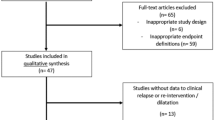Abstract
Background
Crohn’s disease (CD) of the terminal ileum not responding to standard medical treatment is more and more treated with biologics instead of surgery. In order to get more information on the results of surgery, we analyzed the outcome of laparoscopic ileocecal resection (LICR) performed before the widespread use of these drugs.
Methods
Chart reviews and telephone follow-ups were performed on 119 patients treated with laparoscopic ileocecal resection for CD. Follow-ups were performed at a median of 58 (17–124) and 113(69–164) months. Symptomatic restenosis requiring surgery or endoscopic dilatation was the primary endpoint. We further analyzed risk factors of recurrence.
Results
Of the 119 patients initially treated, 18 required surgery (n = 14) or endoscopic dilatation (n = 4). The calculated rates of re-intervention were 10 und 17.5 % at 5 and 10 years, respectively. Ninety percent of the patients had a Crohn-specific medication treatment at the time of surgery, but only 51.4 und 46.9 % at FU 1 und 2, respectively. Smoking increased the risk of recurrence (OR 3.7, P = 0.011).
Conclusion
The data demonstrate excellent long-term results of LICR for CD of the terminal ileum. Surgery should be considered as a first choice treatment in many patients with ileocecal CD not responding to conventional treatment.

Similar content being viewed by others
References
Binder V, Both H, Hansen PK, Hendriksen C, Kreiner S, Torp-Pedersen K (1982) Incidence and prevalence of ulcerative colitis and Crohn’s disease in the County of Copenhagen, 1962 to 1978. Gastroenterology 83:563–568
Peyrin-Biroulet L, Loftus EV Jr, Colombel JF, Sandborn WJ (2010) The natural history of adult Crohn’s disease in population-based cohorts. Am J Gastroenterol 105:289–297
Freeman HJ (2007) Application of the Montreal classification for Crohn’s disease to a single clinician database of 1,015 patients. Can J Gastroenterol = J Can Gastroenterol 21:363–366
Lichtenstein GR, Abreu MT, Cohen R, Tremaine W (2006) American Gastroenterological Association Institute medical position statement on corticosteroids, immunomodulators, and infliximab in inflammatory bowel disease. Gastroenterology 130:935–939
Travis SP, Stange EF, Lemann M, Oresland T, Chowers Y et al (2006) European evidence-based consensus on the diagnosis and management of Crohn’s disease: current management. Gut 55(Suppl 1):i16–i35
Hoffmann JC, Preiss JC, Autschbach F, Buhr HJ, Hauser W et al (2008) Clinical practice guideline on diagnosis and treatment of Crohn’s disease. Z Gastroenterol 46:1094–1146
Rutgeerts P, Goboes K, Peeters M, Hiele M, Penninckx F et al (1991) Effect of fecal stream diversion on recurrence of Crohn’s disease in the neoterminal ileum. Lancet 338:771–774
Yamamoto T (2005) Factors affecting recurrence after surgery for Crohn’s disease. World J Gastroenterol: WJG 11:3971–3979
Cullen G, O’Toole A, Keegan D, Sheahan K, Hyland JM, O’Donoghue DP (2007) Long-term clinical results of ileocecal resection for Crohn’s disease. Inflamm Bowel Dis 13:1369–1373
Maartense S, Dunker MS, Slors JF, Cuesta MA, Pierik EG et al (2006) Laparoscopic-assisted versus open ileocolic resection for Crohn’s disease: a randomized trial. Ann Surg 243:143–149, discussion 50–3
Eshuis EJ, Slors JF, Stokkers PC, Sprangers MA, Ubbink DT et al (2010) Long-term outcomes following laparoscopically assisted versus open ileocolic resection for Crohn’s disease. Br J Surg 97:563–568
Milsom JW, Hammerhofer KA, Bohm B, Marcello P, Elson P, Fazio VW (2001) Prospective, randomized trial comparing laparoscopic versus conventional surgery for refractory ileocolic Crohn’s disease. Dis Colon Rectum 44:1–8, discussion −9
Stocchi L, Milsom JW, Fazio VW (2008) Long-term outcomes of laparoscopic versus open ileocolic resection for Crohn’s disease: follow-up of a prospective randomized trial. Surgery 144:622–627, discussion 7–8
Polle SW, Wind J, Ubbink DT, Hommes DW, Gouma DJ, Bemelman WA (2006) Short-term outcomes after laparoscopic ileocolic resection for Crohn’s disease. A systematic review. Dig Surg 23:346–357
Lesperance K, Martin MJ, Lehmann R, Brounts L, Steele SR (2009) National trends and outcomes for the surgical therapy of ileocolonic Crohn’s disease: a population-based analysis of laparoscopic versus open approaches. J Gastrointest Surg : Off J Soc Surg Aliment Tract 13:1251–1259
Salmon-Ceron D, Tubach F, Lortholary O, Chosidow O, Bretagne S et al (2011) Drug-specific risk of non-tuberculosis opportunistic infections in patients receiving anti-TNF therapy reported to the 3-year prospective French RATIO registry. Ann Rheum Dis 70:616–623
Shale M, Kanfer E, Panaccione R, Ghosh S (2008) Hepatosplenic T cell lymphoma in inflammatory bowel disease. Gut 57:1639–1641
Eshuis EJ, Stokkers PC, Bemelman WA (2010) Decision-making in ileocecal Crohn’s disease management: surgery versus pharmacotherapy. Expert Rev Gastroenterol Hepatol 4:181–189
Cunningham MF, Docherty NG, Coffey JC, Burke JP, O’Connell PR (2010) Postsurgical recurrence of ileal Crohn’s disease: an update on risk factors and intervention points to a central role for impaired host-microflora homeostasis. World J Surg 34:1615–1626
Weston LA, Roberts PL, Schoetz DJ Jr, Coller JA, Murray JJ, Rusin LC (1996) Ileocolic resection for acute presentation of Crohn’s disease of the ileum. Dis Colon Rectum 39:841–846
Simillis C, Yamamoto T, Reese GE, Umegae S, Matsumoto K et al (2008) A meta-analysis comparing incidence of recurrence and indication for reoperation after surgery for perforating versus nonperforating Crohn’s disease. Am J Gastroenterol 103:196–205
Sachar DB, Lemmer E, Ibrahim C, Edden Y, Ullman T et al (2009) Recurrence patterns after first resection for stricturing or penetrating Crohn’s disease. Inflamm Bowel Dis 15:1071–1075
Wolff BG (2001) Resection margins in Crohn’s disease. Br J Surg 88:771–772
Vestweber B, Galetin T, Lammerting K, Paul C, Giehl J et al (2013) Single-incision laparoscopic surgery: outcomes from 224 colonic resections performed at a single center using SILS. Surg Endosc 27:434–442
Author information
Authors and Affiliations
Corresponding author
Rights and permissions
About this article
Cite this article
Rink, A.D., Fischer, I.R., Vestweber, B. et al. Long-term outcome of laparoscopic ileocecal resection for Crohn’s disease before the era of biologics. Int J Colorectal Dis 29, 127–132 (2014). https://doi.org/10.1007/s00384-013-1744-3
Accepted:
Published:
Issue Date:
DOI: https://doi.org/10.1007/s00384-013-1744-3




